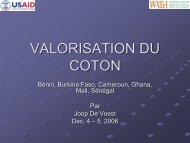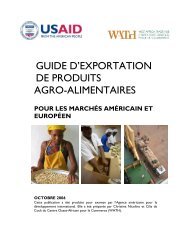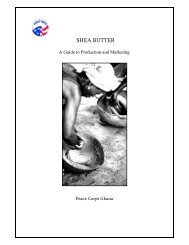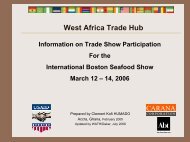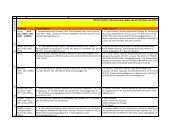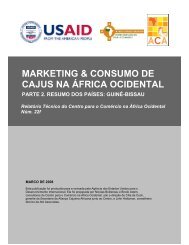A Brief Introduction to Textile Processing - AGOA Export Toolkit
A Brief Introduction to Textile Processing - AGOA Export Toolkit
A Brief Introduction to Textile Processing - AGOA Export Toolkit
You also want an ePaper? Increase the reach of your titles
YUMPU automatically turns print PDFs into web optimized ePapers that Google loves.
They also allow for greater uniformity between garments, which is demanded by most commercial<br />
buyers.<br />
Paper patterns are drawn in the shape and size of each component (e.g. sleeves, collars, pant legs,<br />
waistbands,...) of the garment. They are then arranged on a paper marker <strong>to</strong> determine the most<br />
efficient arrangement of the components on the fabric, so as <strong>to</strong> maximize use of the fabric and<br />
minimize waste.<br />
Cutting. Fifty <strong>to</strong> one – hundred meter (or yard) rolls of fabric are unrolled on<strong>to</strong> large cutting tables<br />
using “spreaders” or devices that unroll and layer the fabric uniformly. Cutting many layers (as many as<br />
twenty-five or fifty) layers of cloth at one time reduces labor significantly, but layers must be smooth<br />
and even <strong>to</strong> prevent dis<strong>to</strong>rtion in the component shapes that would result in defective garments. The<br />
marker is placed on the <strong>to</strong>p layer of fabric, indicating the shapes in<strong>to</strong> which the fabric should be cut.<br />
A worker using a hand - operated saw cuts the fabric in<strong>to</strong> the individual garment components. In<br />
large scale industrial cut and sew operations, laser cutting or dye cutting may be employed for greater<br />
efficiency and accuracy. Each component stack is tied in<strong>to</strong> a bundle and passed <strong>to</strong> the sewers.<br />
Cutting multiple layers of cloth at once is key <strong>to</strong> cost efficiency and quality assurance.<br />
Assembly. Individual components are then sewn <strong>to</strong>gether, or “assembled” <strong>to</strong> form the garment. One<br />
worker performs on step, passes the bundle of components <strong>to</strong> the next worker, who performs the<br />
next step, and so on until the garment assembly is completed.<br />
Knit – <strong>to</strong> - shape<br />
Knit – <strong>to</strong> – shape garments are made by knitting the individual components of a garment according<br />
<strong>to</strong> their finished shape. Individual components are then stitched <strong>to</strong>gether (assembled) with little<br />
additional cutting or trimming. Higher quality sweaters are knit – <strong>to</strong> – shape. They may also be<br />
referred <strong>to</strong> as “full – fashioned.” In knit – <strong>to</strong> – shape apparel manufacturing there is no need <strong>to</strong> spread<br />
and cut layers of fabric.<br />
Product specifications<br />
One of the most important steps in garment manufacturing is <strong>to</strong> develop clear and detailed product<br />
specifications. A product specification is a document that details every aspect of the materials and<br />
findings used <strong>to</strong> produce a given product, the methods of construction used (type and size of seams,<br />
type and size of stitching, type of finishing), design and size of the product, labeling, care<br />
instructions, etc. The product specification should be so detailed and accurate that someone with no<br />
prior knowledge of the product should be able <strong>to</strong> take the specification sheet and manufacture the<br />
garment as intended. The product specification sheet not aids the production managers and<br />
supervisors <strong>to</strong> make every unit of a given product identical It also allows them <strong>to</strong> make sure each unit<br />
conforms <strong>to</strong> the buyer’s expectations. The buyer will compare the products shipped <strong>to</strong> the product<br />
specification sheet, and will reject any units that do not conform. In most cases, if a buyer finds just<br />
one or a few unites that do not conform, s/he will reject the entire shipment, and it will be returned<br />
at the manufacturer’s expense. The time necessary <strong>to</strong> carefully develop a detailed product<br />
specification sheet for each product is time well spent, as carefully written and carefully followed<br />
product specification sheets will greatly reduce the number of costly errors or mistakes in<br />
manufacturing that can quickly ruin a company’s export business.<br />
Prepared by Margaret Bishop and Brent Smith for the West Africa Trade Hub 8/04 16



